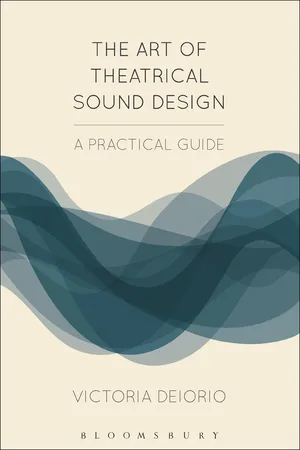
- 240 pages
- English
- PDF
- Available on iOS & Android
eBook - PDF
About this book
Emphasising the artistry behind the decisions made by theatrical sound designers, this guide is for anyone seeking to understand the nature of sound and how to apply it to the stage. Through tried-and-tested advice and lessons in practical application, The Art of Theatrical Sound Design allows developing artists to apply psychology, physiology, sociology, anthropology and all aspects of sound phenomenology to theatrical sound design.
Structured in three parts, the book explores, theoretically, how human beings perceive the vibration of sound; offers exercises to develop support for storytelling by creating an emotional journey for the audience; considers how to collaborate and communicate as a theatre artist; and discusses how to create a cohesive sound design for the stage.
Structured in three parts, the book explores, theoretically, how human beings perceive the vibration of sound; offers exercises to develop support for storytelling by creating an emotional journey for the audience; considers how to collaborate and communicate as a theatre artist; and discusses how to create a cohesive sound design for the stage.
Frequently asked questions
Yes, you can cancel anytime from the Subscription tab in your account settings on the Perlego website. Your subscription will stay active until the end of your current billing period. Learn how to cancel your subscription.
At the moment all of our mobile-responsive ePub books are available to download via the app. Most of our PDFs are also available to download and we're working on making the final remaining ones downloadable now. Learn more here.
Perlego offers two plans: Essential and Complete
- Essential is ideal for learners and professionals who enjoy exploring a wide range of subjects. Access the Essential Library with 800,000+ trusted titles and best-sellers across business, personal growth, and the humanities. Includes unlimited reading time and Standard Read Aloud voice.
- Complete: Perfect for advanced learners and researchers needing full, unrestricted access. Unlock 1.4M+ books across hundreds of subjects, including academic and specialized titles. The Complete Plan also includes advanced features like Premium Read Aloud and Research Assistant.
We are an online textbook subscription service, where you can get access to an entire online library for less than the price of a single book per month. With over 1 million books across 1000+ topics, we’ve got you covered! Learn more here.
Look out for the read-aloud symbol on your next book to see if you can listen to it. The read-aloud tool reads text aloud for you, highlighting the text as it is being read. You can pause it, speed it up and slow it down. Learn more here.
Yes! You can use the Perlego app on both iOS or Android devices to read anytime, anywhere — even offline. Perfect for commutes or when you’re on the go.
Please note we cannot support devices running on iOS 13 and Android 7 or earlier. Learn more about using the app.
Please note we cannot support devices running on iOS 13 and Android 7 or earlier. Learn more about using the app.
Yes, you can access The Art of Theatrical Sound Design by Victoria Deiorio in PDF and/or ePUB format, as well as other popular books in Media & Performing Arts & Theatre Stagecraft & Scenography. We have over one million books available in our catalogue for you to explore.
Information

THEORETIC
FOUNDATION
PART
ONE
This
section
of
the
book
will
help
define
the
evolutionary
and
the
associational
response
in
human
beings
to
sound
and
music.
We
innately
hear
a
specific
way
because
of
the
evolution
of
our
species.
And
our
experiences
create
an
understanding
through
association
of
meaning
and
feeling
with
what
we
hear.
When
we
combine
evolution
and
association
to
sound
and
music,
we
have
a
larger
grasp
of
the
phenomenology
of
sound.
In
the
following,
the
breakdown
of
exactly
what
happens
when
we
hear,
how
we
perceive
it,
and
the
association
of
emotion
and
meaning
will
be
explained.

Table of contents
- Cover
- Contents
- List of Figures
- Introduction
- PART ONE THEORETIC FOUNDATION
- PART TWO CONTEXTUAL APPLICATION AND EXERCISES
- PART THREE THE COLLABORATIVE PROCESS
- Conclusion
- Glossary
- Bibliography
- Index